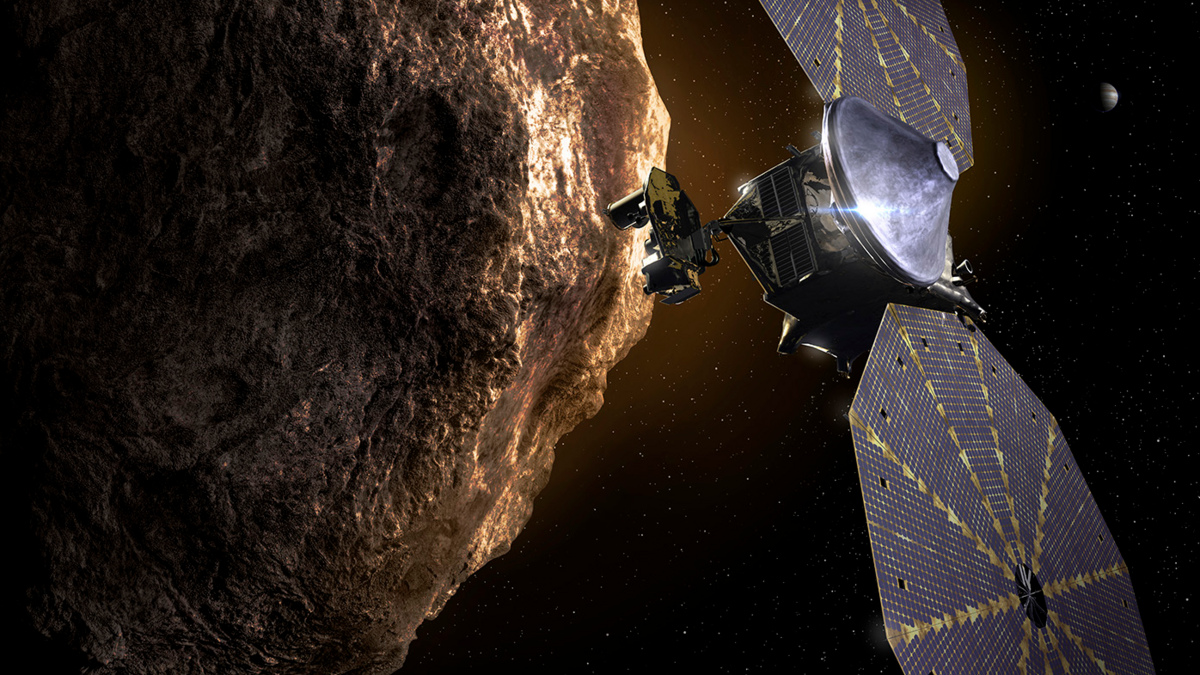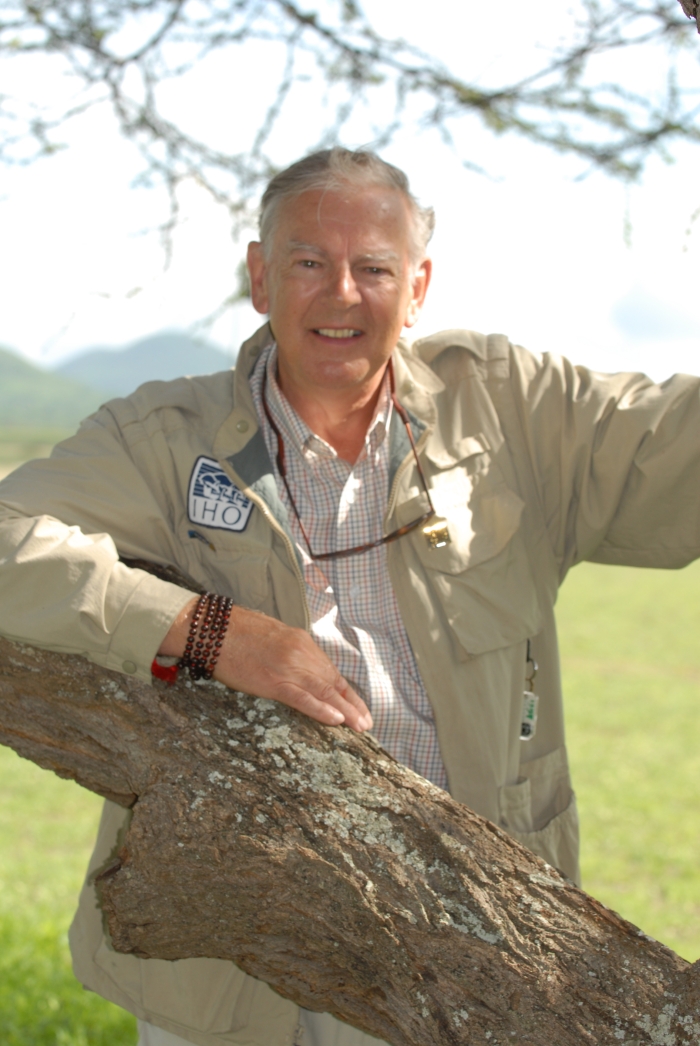NASA Lucy mission carries ASU instrument, namesake — and the hopes of thousands of STEM students

The NASA Lucy mission to the Trojan asteroids is expected to launch on Saturday, Oct. 16, at 5:34 a.m. Eastern (2:34 a.m. Pacific) from Cape Canaveral Space Force Station in Florida. Unique to this mission are the multiple ways that Arizona State University is involved.
The spacecraft itself is named in honor of the 3.2-million-year-old human ancestor fossil “Lucy” discovered in 1974 by Donald Johanson, founding director of ASU’s Institute of Human Origins.
Onboard the spacecraft is the ASU-led instrument, Lucy Thermal Emission Spectrometer (or L’TES for short), which was designed, built and tested on the ASU Tempe campus by Regents Professor Philip Christensen and his team at the School of Earth and Space Exploration.
And watching this launch will be thousands of students who have attended the ASU-led Lucy mission “L’SPACE” Academy, a NASA-funded program in which thousands of undergraduate STEM students from over 650 U.S. colleges and universities are learning what it takes to work at NASA and on space missions.
Lucy will be the first space mission to explore a population of small bodies known as the Jupiter Trojan asteroids. The Trojans are outer solar system asteroids that orbit the sun “leading” and “trailing” the gas giant Jupiter, at the same distance from the sun as Jupiter. These Trojans provide a unique, never-before-explored sample of the remnants of our early solar system.
Just as the Lucy fossil provided unique insights into humanity’s evolution, the Lucy mission promises to revolutionize our knowledge of planetary origins and the formation of the solar system.
Video by NASA Goddard
ASU-led L’TES instrument
The L’TES instrument is similar to instruments flying on OSIRIS-REx and Mars Global Surveyor. Its spectrometer will allow the Lucy team to learn about the properties of the Trojans such as their thermal inertia (how slowly an object heats up or releases heat), which teaches us about the composition and structure of material on the surface of the asteroids.
Though the Trojan asteroids are many hundreds of millions of kilometers from the sun, sunlight still heats them up, causing them to emit far-infrared radiation. L’TES detects this radiation, using a telescope to focus the incoming energy onto a small detector. In this way, L’TES acts like a remote thermometer.
“Our team here at ASU has built similar instruments to L’TES to measure the temperatures of Mars, other asteroids and the moon, and I’m very excited to see how the temperatures and physical properties of the Trojan asteroids compare to these other bodies,” Christensen said. “It is remarkable how different the surfaces of each of these objects can be.”
In addition to L’TES, the Lucy spacecraft includes two other instruments: a combination color visible imager and infrared spectrometer called “L’Ralph” and a long-range reconnaissance imager called “L’LORRI.” Additionally, Lucy will be able to use its high-gain antenna to determine the masses of the targets using the Doppler shift of the radio signal. Lucy will also be able to use its terminal tracking camera (T2CAM) to take wide-field images of the asteroids to better constrain the asteroids shapes.
Video by NASA Goddard
ASU-led L’SPACE Academy
ASU is also participating in the Lucy mission through the innovative NASA “L’SPACE” Academy, which is the official student collaboration program for the mission. This is a free, online, interactive, NASA-funded program is open to undergraduate science, technology, engineering and math (STEM) students interested in pursuing a career with NASA and other space organizations.
L'SPACE consists of two 12-week academies offered each semester, designed to provide unique, hands-on learning and insight into the dynamic world of the space exploration ecosystem. Students learn NASA mission practices, procedures and protocols from NASA and industry professionals as they collaborate with fellow team members from around the U.S. to complete unique mission-related team projects.
“L’SPACE Academy is designed for the needs of the STEM workforce,” said Sheri Klug Boonstra, School of Earth and Space Exploration instructor and academy principal investigator. “Our goal is to provide STEM mentoring, and technical science and engineering training that is accessible and equitable.”
More than 4,500 students have participated in the academy, representing all 50 U.S. states and Puerto Rico and Guam. Since the program's inception, instructors have provided over 700,000 hours of mentoring and STEM workforce training.
Kori Eliaz, a senior in electrical engineering at Colorado State University, is a recent alumna of the L’SPACE program and is currently a L’SPACE mission ambassador, responsible for helping to spread the word about Lucy’s science mission and flight trajectory to audiences across the U.S. She credits the program with helping her land an internship at Lockheed Martin Space Systems, where she is currently a systems engineering intern working on the Dragonfly mission. After graduation in May 2022, Eliaz will begin a full-time position with the Lockheed Martin Dragonfly team.
“L’SPACE is an experience and a family that will stay with you forever and propel you to new heights you never thought imaginable,” Eliaz said. “Not only does L’SPACE teach students the technical skills they need to stand out from their peers, it also teaches students how to be team players, good collaborators and, most importantly, to believe in themselves.”
Launch from Kennedy Space Center
L’TES instrument Principal Investigator Christensen and his team will be attending the launch of the Lucy spacecraft at Kennedy Space Center, as will 500 L’SPACE Academy alumni and their families and friends, along with Klug Boonstra and her staff from L’SPACE Academy.
After launch, Lucy Team members, L’SPACE staff and Lucy mission ambassadors, including Eliaz, will be on hand at Kennedy Space Center to answer questions about the mission and provide fun Lucy-centric family activities for guests.
“The absolute best part of being a Lucy mission ambassador is getting to see the spark light up in the audience’s eyes when they hear about all the incredible facets of the mission,” Eliaz said. “From the sheer size of Lucy’s solar panels, to the revolutionary orbital trajectory that will keep the spacecraft traveling between Earth and Jupiter’s Trojan asteroids for years and years to come, Lucy is an incredible mission that inspires people of all ages and from all backgrounds.”
Donald Johanson, founding director of ASU’s Institute of Human Origins, discovered the 3.2-million-year-old human ancestor fossil “Lucy" in 1974.
Also attending launch will be paleoanthropologist and Lucy discoverer Johanson who, in addition to being the founding director ASU’s Institute of Human Origins, is also the Virginia M. Ullman Chair in Human Origins with the School of Human Evolution and Social Change. His important connection with the mission, in addition to having the mission named after the human ancestor fossil “Lucy,” is that an asteroid named in his honor — 52246 Donaldjohanson — is the smallest of the asteroids that the mission will fly by in 2025 as a first test of the spacecraft.
Johanson has been invited as a special guest to the mission launch and will be providing a mission briefing on Friday, Oct. 15, at the Center for Space Education at the Kennedy Space Center Visitor Complex to NASA guests on site for the launch.
First-place winners of the “Lucy in Space” contest, an Institute of Human Origins-led competition held in partnership with NASA and the Southwest Research Institute, will also be special guests of the launch. This national contest was for middle and high school students to make a connection between our human drive for discovery and exploration of our origins on Earth and in our own solar system.
The first-place winner in the high school category, Sarah Tran, is a senior at Hamilton High School in Chandler, Arizona, and will attend the launch with her father, Hung Tran, and her teacher, Mark Jordan. The middle school winner, Tim Topping from St. Mary Catholic School in Littleton, Colorado, will attend with his family.
The public is invited to watch the launch on NASA TV and to register to attend the online event, which is expected to take place on Saturday, Oct. 16, at 5:34 a.m. Eastern (2:34 a.m. Pacific).
About the Lucy mission
Lucy is a Discovery-class mission led by Principal Investigator Harold "Hal" Levison based out of the Boulder, Colorado, branch of Southwest Research Institute, headquartered in San Antonio, who — with a team of scientists and engineers — will address key science questions about the solar system. NASA’s Goddard Space Flight Center in Greenbelt, Maryland, provides overall mission management, systems engineering, and safety and mission assurance. Lockheed Martin Space Systems in Denver built the spacecraft. Instruments are provided by Goddard, the Johns Hopkins Applied Physics Laboratory in Laurel, Maryland, and ASU. Discovery missions are overseen by the Planetary Missions Program Office at NASA's Marshall Space Flight Center in Huntsville, Alabama, for NASA’s Planetary Science Division.
Top image: An artist’s rendition of the Lucy spacecraft passing one of the Trojan asteroids near Jupiter. Credit: Southwest Research Institute
More Science and technology

Breakthrough copper alloy achieves unprecedented high-temperature performance
A team of researchers from Arizona State University, the U.S. Army Research Laboratory, Lehigh University and Louisiana State University has developed a groundbreaking high-temperature copper alloy…

4 ASU researchers named senior members of the National Academy of Inventors
The National Academy of Inventors recently named four Arizona State University researchers as senior members to the prestigious organization.Professor Qiang Chen and associate professors Matthew…

Transforming Arizona’s highways for a smoother drive
Imagine you’re driving down a smooth stretch of road. Your tires have firm traction. There are no potholes you need to swerve to avoid. Your suspension feels responsive. You’re relaxed and focused on…


